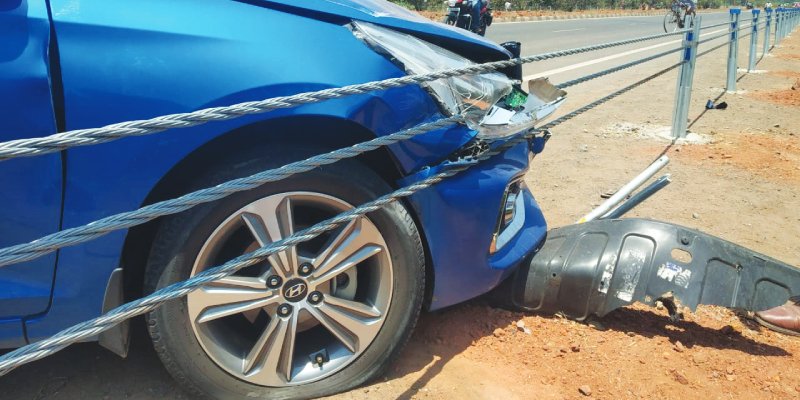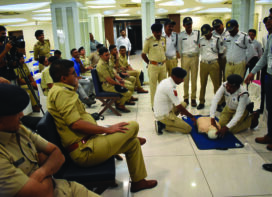
Bharat Anand, Partner, Safety First
Wire Rope Safety Barrier is light and cost effective; we need to innovate its usage to help reduce fatalities, road accidents, says Bharat Anand, Partner, Safety First while talking to Valencia Fernandes
What is the importance of the use of Wire Rope Barriers in the context to Indian Road Safety?
Wire Rope Safety Barriers (WRSB) are a fairly old product worldwide, being developed in the mid-1990s. It is a very cost-effective product first and foremost, but more importantly, as far as safety is concerned, it is at par or better than most of the products available worldwide. The system was developed by the premise that if a 20-ton fighter jet coming at insane speeds gets stopped within the concise space on an aircraft carrier using a single wire rope, why can’t a car, truck or bus. We use pretty much the similar wires in the wire rope barrier, but instead use 3 or 4 wires installed together. Thus the wire barrier has a lot more strength than a steel barrier. Typical breaking capacity of the Wire Rope Barrier Systems is between 60-100 tons. Typically, steel barrier would be around 30-40 tons traditionally. So, you’re giving 1½ ton times the weight bearing capacity.
Secondly, the most important thing is that the wires are highly flexible. Although they are containing the vehicles within a certain space, the impact to the vehicle and the passenger is much lesser. Earlier, much attention was not paid as to where the barriers were being installed. Every product cannot be installed everywhere. So there has been a lot of wrong implementations of WRSB mainly because it looks light.
The way WRSB is supposed to work is that the post that keeps the wire in place bends and lets the wire come out. It is designed to bend and when the vehicle interacts with the barrier; the latter absorbs most of the kinetic energy with less impact on the vehicle and the passengers. Moreover, with the same amount of money one can install a lot more of WRSB
than concrete crash barrier or metal barriers.
You have installed wire rope barriers for projects in Odisha and in Andhra Pradesh…
When the 467 km stretch from Siddhantham to Ichchapuram Section of NH-5(NH-16) in the states of Orissa and Andhra Pradesh was to be upgraded, the EPC contractor Ashoka Buildcon brought us in. It took a five-hour session to convince the officials to allow using crash tested WRSB instead of the metal barriers that they were planning to install. Our company actually did a mix of both. The designs used are the same which are currently used globally in over 30+ countries and also recommended by the latest IRC manuals for traffic safety barriers. In spite of resistance from different quarters, we could complete the project. It has now been running for four years and the barriers are properly maintained as well.
Between 2018 and 2019, both Ashoka Buildcon and Safeway Concessions were collecting data on the accidents. Along the way from Vishakhapatnam to Raj Mundari in Andhra Pradesh, which is roughly 300 kilometers, there’s a stretch where rope barriers are installed and the accidents, injuries and death ratio have dramatically gone down. It is also a route frequented by truck drivers as it’s one of the main port roads between Vishakhapatnam and Chennai. Most of the accidents were unreported, as the impact was so low that 95% of the times, the vehicle would drive off leaving only a bumper behind.

What about more of WRSB on national highways?
The main hurdles are the perception that WRSB are not strong enough to stop an accident and also that it cannot be maintained. In fact, maintenance cost is 60% lower than a traditional barrier and the serious accidents have come down too.
There are few other places where they are very good, like where there is a lot of sand and a lot of snow. What happens is if you have rigid barriers, there would be a lot of accumulation of sand and snow on the road, whereas with WRSB, they get blown off.
One of the disadvantages of the WRSB is that there’s a lot of deflection. Safety wise, it is a good feature, but space wise, it is a bit of a constraint.
WRSB is inherently a double sided barrier and it is very suitable for medians. For example the US installs approximately 6000 kilometers of WRSB every year on its expressways as these have wide medians. We are aware of the Delhi-Vadodara express highway, part of the Delhi Mumbai expressway, that has a 16-meter-wide median which is not barricaded – could be an ideal use of this technology.
Currently there are many expressways coming up with very wide medians. The wide barrier in the middle prevents vehicles going from one side to other. All the data points out that 80% of the deaths all over the world happen because vehicles cross from one side to the other.
Noise barriers are also very important…
One, the amount of ambient noise created on roads, because of horns, vehicles, tyres, engines and everything, the decibel levels not only in India, but around the world has increased. The noise barriers are also important in natural parks with wild life. For example, the Delhi- Mumbai expressway is going through the MP national park and has many animal underpasses and overpasses. The stretch demands noise barriers as well.
Earlier, there were not enough noise barriers and the materials used were also of varied quality. So the IRC took cognizance of this in 2018 and as part of the environmental committee, it decided to make new guidelines for noise barriers. IRC spent at least 3-4 years preparing the guidelines. The Guidelines have received many suggestions that were incorporated and the guidelines have now been published.

Future of Noise Barriers in India…
With all these expressways that are being built through national parks, residential areas and even within cities, the need for noise barriers has increased. It’s a big growth sector within the road industry and with these guidelines, it will ensure that quality products get installed so that the total cost of ownership over a lifetime is actually much lower. The earlier noise barriers required six monthly maintenance. But proper noise barrier should last about 10-15 years.
One of the important things that was ignored in our country was the stability of the noise barrier. When you put a 4mm plastic sheet, it is able to deflect the sound back towards the other side, but the wind load that comes on the bridge and barrier is immense, especially when you’re going through wildlife zones. The barrier has to not only absorb the sound and stop the sound from going towards the other side, but it also has to stop light pollution to protect wildlife. So it needs to be opaque. That’s something people have not understood for a long time in our country. Now the Natural Green Tribunal has made it mandatory that any NB that is installed in a wildlife zone should be opaque.
 TrafficInfraTech Magazine Linking People Places & Progress
TrafficInfraTech Magazine Linking People Places & Progress

